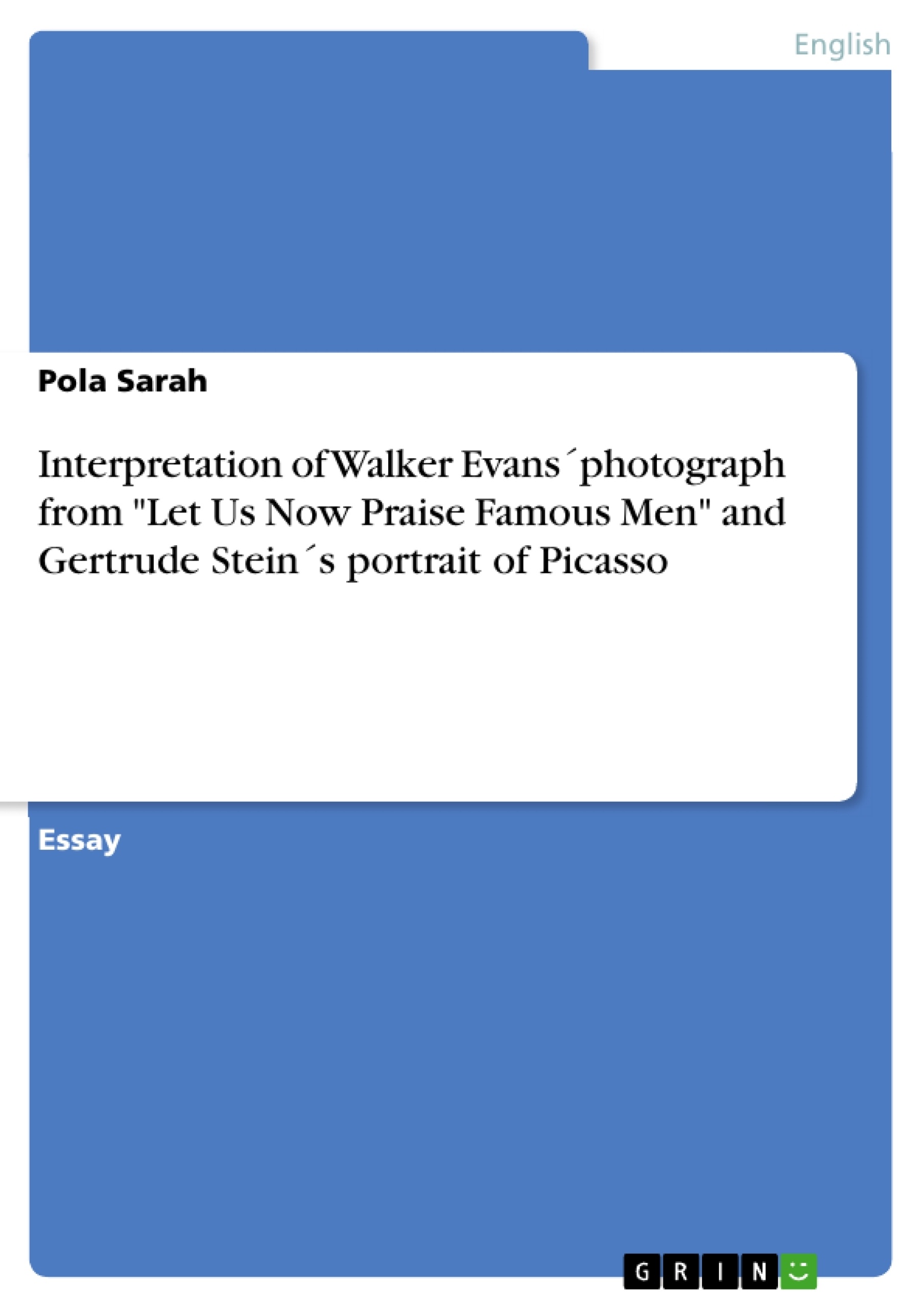This paper contains two essays on the following topics:
Interpret Walker Evans’ photograph from Let Us Now Praise Famous Men by drawing on John Dewey’s programmatic statement:
“The task is to restore continuity between the refinde and intesified forms of experience that are works of art and the everyday events, doings, and sufferings that are universally recognized to constitute experience.” (John Dewey, Art as Experience)
Use Altieri’s comment in interpreting Stein’s portrait of Picasso
“Stein shows that language can itself play various substances and registers against each one another, so that the word takes on a cubist density of perspectives and facets that echo and contrast with each other” (Charles Altieri, Painterly Abstraction in Modernis American Poetry: The Contamporaneity of Modernism (1989))
Table of Contents
- 1. Walker Evans
- 2. Stein Altieri
Objectives and Key Themes
This text analyzes two distinct works of art, aiming to explore how each artist uniquely captures and conveys meaning. The analysis draws upon the theories of John Dewey and Charles Altieri to illuminate the artistic techniques and the social and cultural contexts of the works.
- The relationship between art and everyday life
- The representation of poverty and social inequality
- The use of photographic and literary techniques to convey meaning
- Cubist principles in both visual art and literature
- The role of art as social commentary
Chapter Summaries
1. Walker Evans: This chapter analyzes a photograph by Walker Evans from "Let Us Now Praise Famous Men," focusing on its depiction of poverty among sharecroppers during the Great Depression. The analysis draws on John Dewey's concept of bridging the gap between art and everyday experience. The chapter argues that Evans' seemingly simple photograph transcends mere documentation, achieving artistic significance through its subtle details and composition, conveying the hardships faced by the farmers without resorting to sentimentality. The image's elements, such as the simple wooden wall and the centrally placed silverware, symbolize the hard work and meager rewards of the farmers' lives. The chapter discusses the broader context of American photography during the Great Depression and how Evans' work contributed to a new form of social documentary photography.
2. Stein Altieri: This chapter examines Gertrude Stein's portrait of Picasso, interpreting it through Charles Altieri's concept of "cubist density of perspectives." The analysis explores how Stein's use of repetitive phrasing and contrasting viewpoints creates a multi-faceted portrayal of Picasso, mirroring the cubist aesthetic in visual art. The chapter contrasts the initial description focusing on Picasso's charm with a subsequent description of his artistic success and future potential. Stein's technique is presented as a form of literary cubism, building a complex portrait without resorting to biographical details or emotional appeals. The comparison to film further emphasizes the fragmented yet cohesive nature of Stein's literary style.
Keywords
Walker Evans, John Dewey, photography, Great Depression, social documentary, poverty, Gertrude Stein, Charles Altieri, Picasso, cubism, literary techniques, art and life, social commentary, repetition, perspective.
Frequently Asked Questions: A Comparative Analysis of Walker Evans and Gertrude Stein
What is the main focus of this text?
This text provides a comprehensive analysis of two distinct works of art: a photograph by Walker Evans and a literary portrait of Picasso by Gertrude Stein. It explores how each artist uniquely conveys meaning, drawing upon the theories of John Dewey and Charles Altieri to illuminate artistic techniques and socio-cultural contexts.
Which artists are analyzed in this text?
The text analyzes the works of Walker Evans (photography) and Gertrude Stein (literature).
What are the key themes explored in the analysis?
Key themes include the relationship between art and everyday life, the representation of poverty and social inequality, the use of photographic and literary techniques to convey meaning, Cubist principles in both visual and literary art, and the role of art as social commentary.
How does the analysis of Walker Evans' photograph proceed?
The analysis of Walker Evans' photograph from "Let Us Now Praise Famous Men" focuses on its depiction of poverty among sharecroppers during the Great Depression. It uses John Dewey's theories to examine how the seemingly simple photograph transcends mere documentation, achieving artistic significance through subtle details and composition. The chapter discusses the broader context of American photography during the Great Depression and Evans' contribution to social documentary photography.
How is Gertrude Stein's work analyzed?
The analysis of Gertrude Stein's portrait of Picasso utilizes Charles Altieri's concept of "cubist density of perspectives." It explores how Stein's repetitive phrasing and contrasting viewpoints create a multifaceted portrayal, mirroring the cubist aesthetic in visual art. The analysis compares Stein's literary technique to film, highlighting the fragmented yet cohesive nature of her style.
What theoretical frameworks are used in the analysis?
The analysis draws upon the theories of John Dewey (regarding the relationship between art and everyday experience) and Charles Altieri (regarding "cubist density of perspectives").
What are some of the key concepts discussed in relation to Walker Evans' work?
Key concepts related to Walker Evans include social documentary photography, the depiction of poverty during the Great Depression, and the artistic significance of seemingly simple photographs.
What are some of the key concepts discussed in relation to Gertrude Stein's work?
Key concepts related to Gertrude Stein include literary cubism, the use of repetition and contrasting viewpoints to create a multifaceted portrait, and the comparison of her literary style to film.
What are the keywords associated with this text?
Keywords include: Walker Evans, John Dewey, photography, Great Depression, social documentary, poverty, Gertrude Stein, Charles Altieri, Picasso, cubism, literary techniques, art and life, social commentary, repetition, perspective.
What is the structure of the text?
The text includes a table of contents, objectives and key themes, chapter summaries (one each for Walker Evans and Gertrude Stein), and keywords.
- Citar trabajo
- Pola Sarah (Autor), 2010, Interpretation of Walker Evans´photograph from "Let Us Now Praise Famous Men" and Gertrude Stein´s portrait of Picasso, Múnich, GRIN Verlag, https://www.grin.com/document/184801



